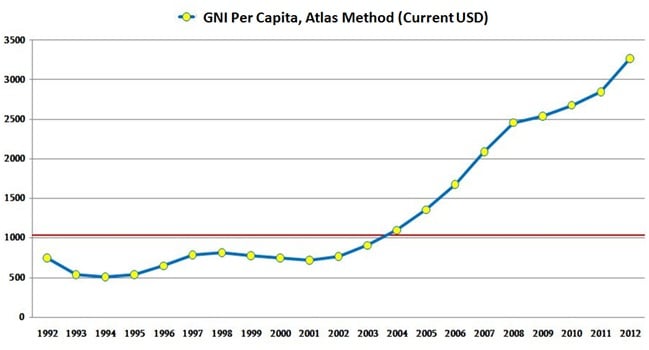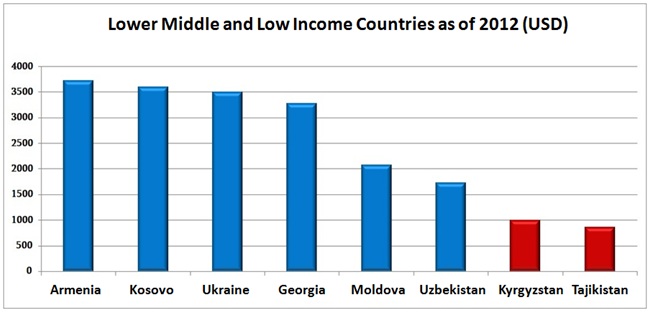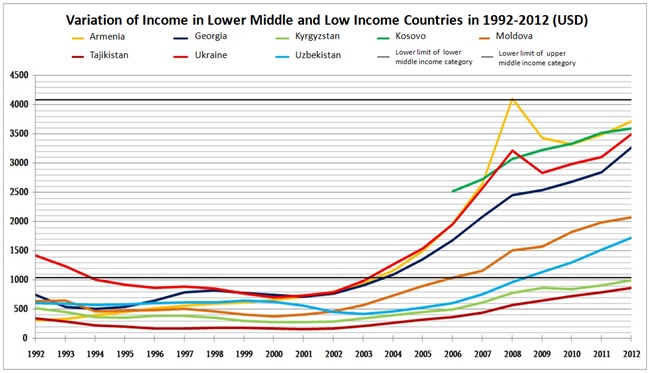On 18 February 2014 Prime Minister Irakli Gharibashvili and the government economic team met with representatives of the World Bank. The attending officials discussed the socio-economic development strategy of the country – Georgia 2020. In his comment to journalists, the Prime Minister also noted that: “In terms of poverty, Georgia maintainsone of the lowest indicators in Central Asia and Eastern Europe.” He further clarified that his statement was based upon the findings of the World Bank.
FactChecktook interest in the Prime Minister’s statement and verified its accuracy.
In the data of the World Bank the decisive indicator for measuring poverty is income. The World Bank classifies the economies based upon theirGNI per capita into the following categories:low income, middle income (subdivided into lower middle and upper middle) or high income.
In line with the latest 2012 indices of the World Bank, 20 countries are united in the region of Central Asia and Eastern Europe. The following countries are included in the category of upper middle income countries: Albania, Azerbaijan, Belarus, Bosnia-Herzegovina, Bulgaria, Kazakhstan, Macedonia, Montenegro, Romania, Serbia, Turkey and Turkmenistan. Only six states of Central Asia and Eastern Europe are categorised as lower middle income countries: Georgia, Armenia, Kosovo[i],Moldova, Ukraine and Uzbekistan. Kyrgyzstan and Tajikistan belong to the lowermost category of low income countries.
The heading ‘low income countries’ unites countries whose GNI per capita (Atlas method) is equal to or below USD 1,035. Countries with a GNI per capita ranging from USD 1,036 to USD 4,085 belong to the lower middle income grouping, those with a GNI per capita between USD 4,086 and USD 12,615 belong to the upper middle income countries while the indicator equal to or above USD 12,616 qualifies a state for a high income category.
In 2004 Georgia moved from the category of low income countries up to the upper middle income grouping. In accordance with the statistical dataof the World Bank, throughout the years 2004-2012 the GNI per capita (Atlas method) of Georgia grew steadily each year (see the graph below); the witnessed growth, however, was not large enough to ensure Georgia’s advance to the next category. (The red line on the graph indicates the GNI per capita minimum required from a state in order qualify for the lower middle income category.)
 Based upon the data
Based upon the data of 2011, Georgia’s GNI per capita totalled USD 2,850. In 2012, the indicator rose to USD 3,270. We also looked into the indices of the other five states included in the category of lower middle income countries. In line with the data of 2012, the GNI per capita indicator of Armenia stands at USD 3,720, Kosovo – USD 3,600, Ukraine – USD 3,500, Moldova – USD 2,070, Uzbekistan – USD 1,720. Consequently, in the category of lower middle income countries Georgia falls behind Armenia, Kosovo and Ukraine.


It is also of importance to point out that according to the 2010 data of the World Bank, about 18% of the Georgian population was below the poverty threshold having the PPP (Purchasing Power Parity) of no more than USD 1.25 which implies that their daily consumption did not exceed USD 1.25. The data of 2011, 2012 and 2013 are yet to be published.
Conclusion
In line with the 2012 data of the World Bank, 20 countries are united in the region of Central Asia and Eastern Europe with 12 of these states belonging to the category of upper middle income countries which implies that the GNI per capita (Atlas method) varies between USD 4,086 and USD 12,615. Six countries fall into the category of lower middle income countries which means that the GNI per capita varies from USD 1,036 to USD 4,085. In the given region, only Kyrgyzstan and Tajikistan belong to the category of low income countries.
With its income indices, Georgia falls into the lower middle income category. According to the 2012 data Georgia’s GNI per capita (Atlas method) totalled USD 3,270 and in the course of the period 2004-2012 the indicator was increasing each year. In the group of lower middle income countries Georgia falls behind Armenia, Kosovo and Ukraine and surpasses Uzbekistan and Moldova.
Georgia does not stand on the lowest position in terms of poverty indices in the region of Central Asia and Eastern Europe but its indicator for GNI per capita exceeds only that of Uzbekistan, Moldova (lower middle income category), Kyrgyzstan and Tajikistan (low income category) but falls behind 15 countries of the region.
Consequently, we conclude that Irakli Gharibashvili’s statement, “In terms of poverty, Georgia maintains one of the lowest indicators in Central Asia and Eastern Europe,” is TRUE.
Georgia does not recognise the Republic of Kosovo






 “In terms of poverty, Georgia maintains one of the lowest indicators in Central Asia and Eastern Europe.”
“In terms of poverty, Georgia maintains one of the lowest indicators in Central Asia and Eastern Europe.”


